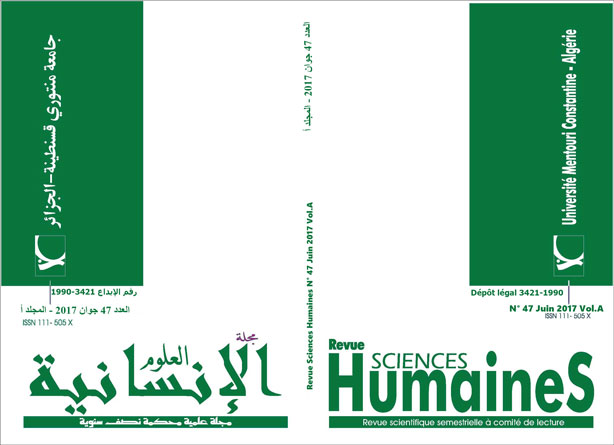Un-English Accentual Patterns of the Interlanguage Prosody of Students Reading for a Master’s Degree in Applied Language Studies, University of Constantine: Underlying Causes and Remedial Didactic Practices
Mots-clés :
Un-English, Accentual Patterns, Interlanguage Prosody, Students Reading, Master’s Degree, Applied Language Studies, University of Constantine, Causes, Remedial, Didactic PracticesRésumé
The author of the present research paper digitally recorded the renderings of 260 monomorphemic and affix words of different accentual patterns and moraic structures along with ten utterances performed by thirty two MA English majors at the Department of Letters and English Language, Constantine University 1. This paper reports on the inferred causes underlying the diagnosed stress-allocation errors, and remedial didactic insights are sketched out. The findings reveal that the respondents have not accommodated their interlanguage phonology to L2 parameters due to a number of interlocked factors: (1) lack of internalised rules regarding stress correlates and stress-assignment guidelines; (2) non-strategic and infrequent usage of print and electronic dictionaries; (3) failure to take advantage of the copious merits of Computer Assisted Pronunciation Learning and (4) shallow pronunciation-promoting strategies.Téléchargements
Références
Andersen, R. (1983). Transfer to Somewhere. In S. M. Gass & L. Selinker (eds.), Language Transfer in Language Learning, Rowley, MA: Newbury House, 177–201.
Beghoul, Y. (2007). The Phonological Interlanguage of the Undergraduate Students at the Department of English, University of Mentouri, Constantine. Unpublished Doctorate Thesis. Constantine: Mentouri University.
Bild, E.R. and M. Swain. (1989). “Minority Language Students in a French Immersion Programme: Their French Proficiency”. Journal of Multilingual and Multicultural Development 10(3): 255-274.
Cenoz, J. (2001). The Effect of Linguistic Distance, L2 Status and Age on Cross-linguistic Influence in Third Language Acquisition. In J. Cenoz, B. Hufeisen, and U. Jessner (Eds.), Cross-linguistic Influence in Third Language Acquisition: Psycholinguistic Perspectives (8–20). Clevedon, UK: Multilingual Matters.
Corder, S. P. (1973). Introducing Applied Linguistics. London: Penguin Books.
Cruttenden, A. (2014). Gimson’s Pronunciation of English. New York: Routledge.
Crystal, D. (2008). A First Dictionary of Linguistics and Phonetics. Cambridge: Cambridge University Press.
Elimat, A.K and Abuseikeel, A.F. (2014). Automatic Speech Recognition Technology as an Effective Means for Teaching Pronunciation. Jaltcall Journal 10 (1), 21-47.
Ellis, R. (1997). Introductions to Language Study: Second Language Acquisition. Oxford: Oxford University Press.
Gass, S.M. and Selinker, L. (2008). Second Language Acquisition: an Introductory Course. London: Routeledge.
Hansen, Jette. G, and Zampini, Mary. L. (ed). (2008). Phonology and Second Language Acquisition: Philadelphia: John Benjamins.
Haugen, E. (1956). Bilingualism in the Americas: A Bibliography and Research Guide. Baltimore: American Dialect Society.
James, C. (1980). Contrastive Analysis. Essex: Longman.
Juffs, A. (1990). Tone, Syllable Structure and Interlanguage Phonology: Chinese Learners’ Stress Errors. International Review of Applied Linguistics 28 (2), 99–117.
Kellerman, E. (1995). Crosslinguistic Influence: Transfer to Nowhere? Annual Review of Applied Linguistics 15, 125–150.
Kenworthy, J. (1987). Teaching English Pronunciation. London: Longman.
Lukyenchanko, A, William J, I and Nan J. (2011). Open Your Ears. The Role of L1 in Processing of Non-Native Prosodic Contrasts. In Selected Proceedings of 2010 Second Language Research Forum, ed, Gisela Gamena et al., 50-62. Somerville. MA: Cascadilla Proceedings Project.
McCathy, M. (2001). Issues in Applied Linguistics. Cambridge: Cambridge University Press.
Odlin, T. (1989). Language Transfer: Cross-linguistic Influence in Language Learning. Cambridge: Cambridge University Press.
Richards, J.C. (1974). Error Analysis: Perspectives on Second Language Acquisition. London: Longman Group.
Ringom, H. (2007). Crosslinguistic Similarity in Foreign Language Learning. Multilingual Matters: Clevedon.
Roach, P. (2009). English Phonetics and Phonology (4th edition). Cambridge: Cambridge
University Press.
Rothman, J. and J. Cabrelli-Amaro. (2010). “What Variables Condition Syntactic Transfer? A Look at the L3 Initial State”. Second Language Research 26 (2): 189-218.
Selinker, L. (1972). ‘Interlanguage’. International Review of Applied Linguistics 10: 209-31.
Weinreich, U. (1953). Languages in Contact. New York: Linguistic Circle of New York.
Wenk, B. (1985). Speech Rhythms in Second Language Acquisition. Language and Speech 28 (2), 157–175.
















